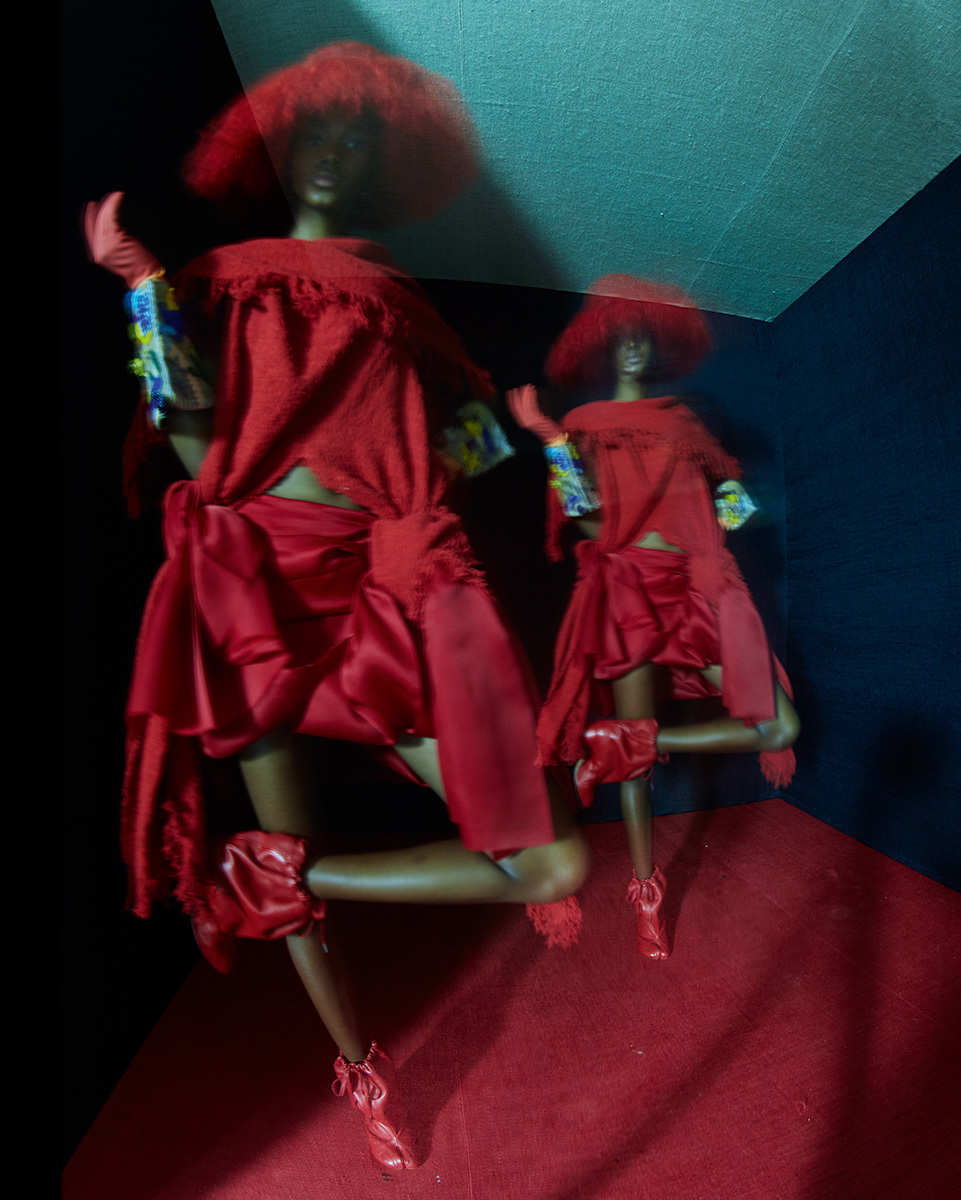The black Mercedes-Benz parked on the curb outside the subtle Maison Margiela building in Paris’s gritty 11th arrondissement gives it away. He’s in there. I’m whisked through the labyrinthine corridors of the former convent where everything is covered in white paint: an antechamber, a staircase, a room, another room, another staircase, a courtyard, through doors, around corners — and there he materializes, at the back of a great, long studio, perched on a gilded salon chair, John Galliano, smiling. “Hello,” he greets me. I’ve always thought of him as a unicorn. The image first came to me a few years ago when I saw him on a bench in Les Marais in some majestic outfit, alone, scribbling in a notebook in all his rare magnificence. He looked so otherworldly there, in the midst of the everyday routine in pedestrian Paris. The light shines differently on John Galliano. Since he joined Maison Margiela in 2014, he’s become one of the most relevant and elusive designers in fashion all at once. He’s not anonymous the way Martin Margiela was, but the triumphant runway bows that once embodied his fashion royalty are now replaced with an alluring absence. He doesn’t come out for a bow. His elaborate collection narratives, once so publicized, are now merely implied in third-person statements from the house. He rarely speaks to the press.
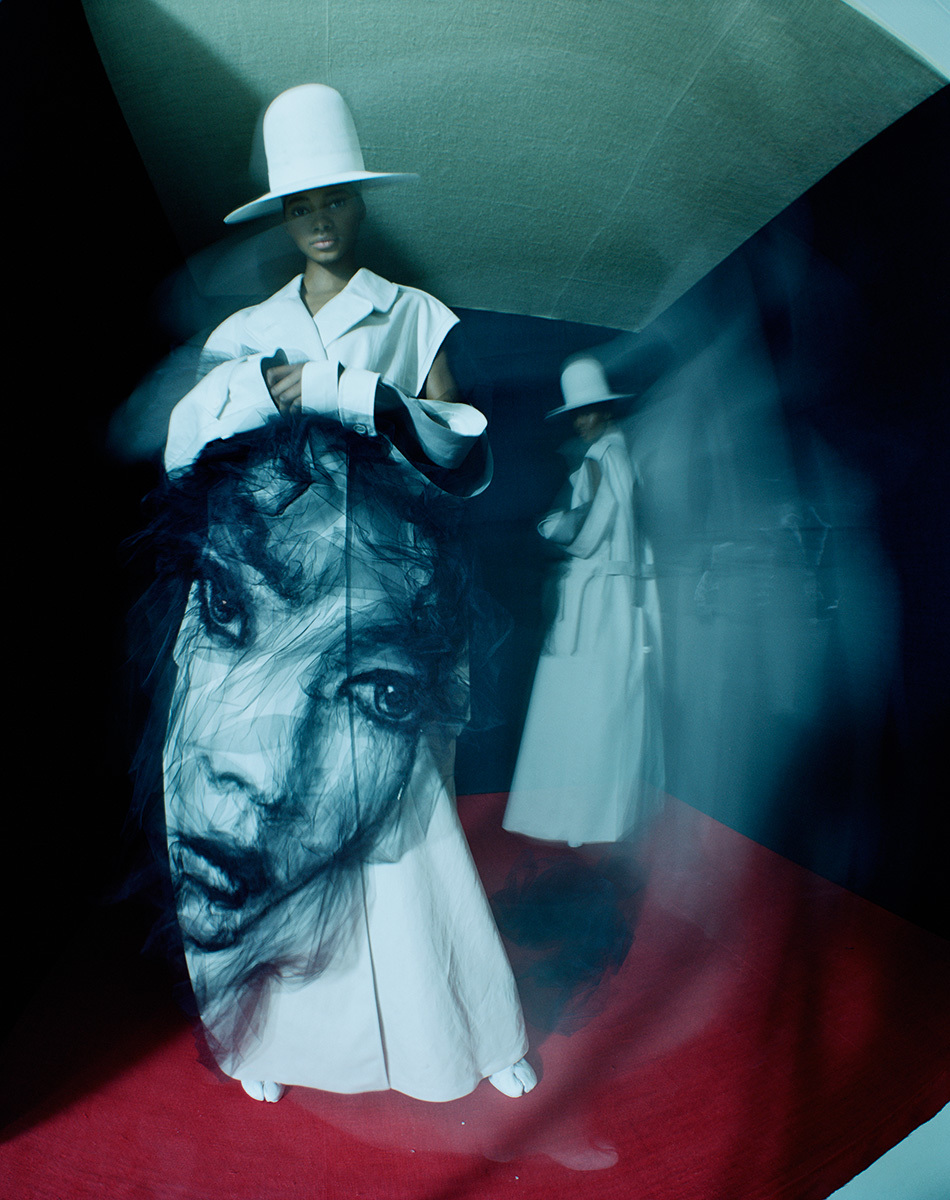
Through this transition, as fashion gawps at his enigmatic collections for Maison Margiela and seeks to uncover what he’s trying to say, Galliano’s voice has grown stronger than ever. As has his myth. Here, in the heart of his creative world, alive and kicking, he’s still as otherworldly as ever, no statement as straightforward as his jaunty demeanor might lead you to believe. At Maison Margiela, everything is veiled in filters. It’s perhaps the reason why the Instagram generation worships its legacy so much. The digital communication that’s changing our social language is the premise for Galliano’s spring/summer 17 Artisanal collection, the house term for haute couture, summed up this season in an avant-garde futuristic folklore. He’s days away from showing it on the runway. “I think I very gaily said at the end of ready-to-wear, ‘oh fuck it, let’s just grab our rucksack, roll up our yoga mats, and let’s all pray,'” he recounts, referring to a 2016 defined by the terror attacks that transformed the Paris he calls home. “I read somewhere that people reached out to the Dalai Lama to help find a solution, and asked would he pray to God? And he said, ‘No. You made this problem. You need to sort it out.’ That led me to Snapchat and how people communicate today.”
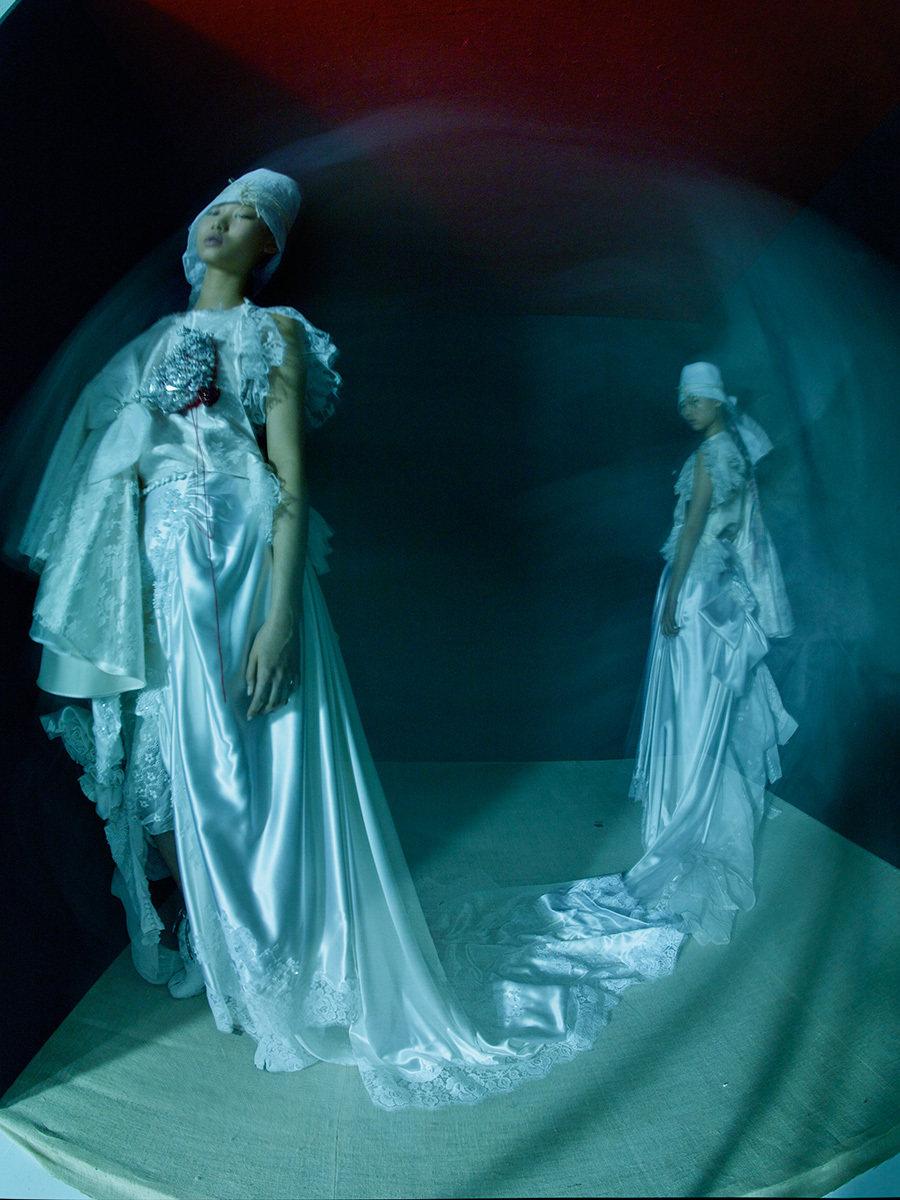
Galliano speaks with the kind of prophetic clarity that makes people listen when he decides to talk. “Because,” he continues, “communication is so much easier today, isn’t it? Yet, I read somewhere that 50% of the population is still lonely. Can you imagine? And 49% of them are on Snapchat and social media. There’s this loneliness or melancholia, if you like,” he pauses. “It’s like we build higher and higher and can’t see the sky anymore.” You get the impression he’s equal parts fascinated and cautious about the social media sphere. On his personal Instagram, he takes part in the online community but his posts are infrequent and highly selective. Instead, in suitable Margiela style, he observes from behind the scenes, watching the innate digital communication of people like Paolina Russo, a Central Saint Martins student from Toronto currently on a placement at the house. She looks like a human rainbow: dressed like a Fabergé egg, she graphically paints her face in multi-colors similar to the illustrations she posts on Instagram, and at 21, speaks the digital language with intrinsic fluency. “She has a relationship with a young guy in London, and they communicate in symbols and emojis,” Galliano says, referring to Russo’s set designer boyfriend Aidan Zamiri.
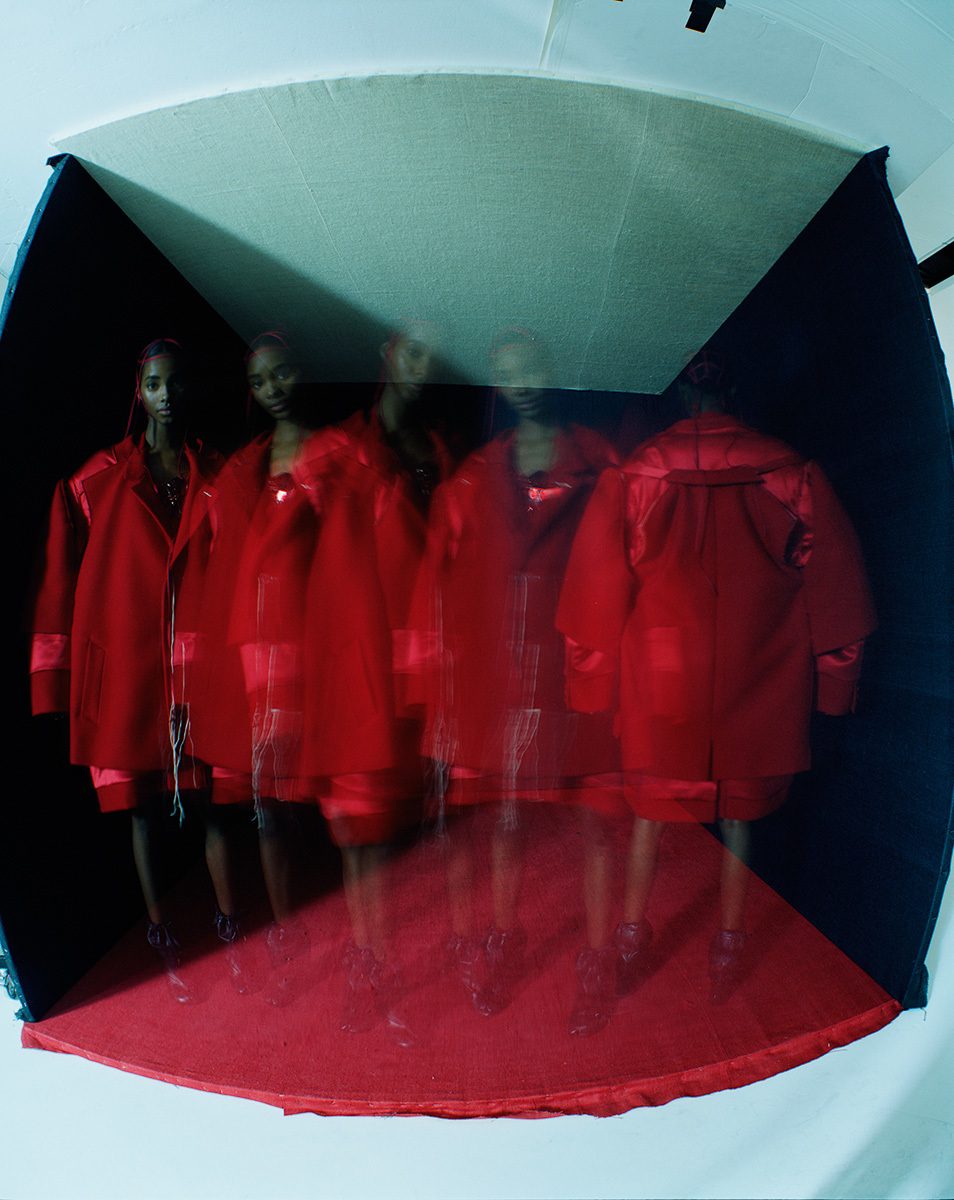
“I was talking to Paolina about the feeling and she said, ‘Yeah, yeah, I can relate, he tattoos me and I tattoo him.’ She’s quite an amazing spirit.” The feeling, as it were, refers to the collection, which employs a new technique Galliano calls decortiqué. In the background, Joan Baez is lamenting lost love on “Diamonds & Rust” from 1975, which is playing on repeat. He’ll use it for the show soundtrack, too. “I think Joan wrote it after she split up with Bob Dylan. It’s full of poetry and she communicates it so beautifully, what she’s feeling,” he says. “If you listen to these lyrics it’s like emotions only come from memories. So often we go into things with an emotion that comes from a memory. She’s quite fearless in what she’s saying.” He stops, dwelling on the haunting lyrics. “So we’re bringing everything down to just the memory of a shirt, the memory of a coat. We call it decortiqué, which means to take a fish off the bone. You bring it right down to the essence.” It’s Galliano’s translation of the digital language into haute couture, the tongue he’s most fluent in: a multi-layering of fabric as filters, deconstructed to reconstruct new images within the single garment they make up. “When you put all these layers together you get the communication: the full picture,” he explains.
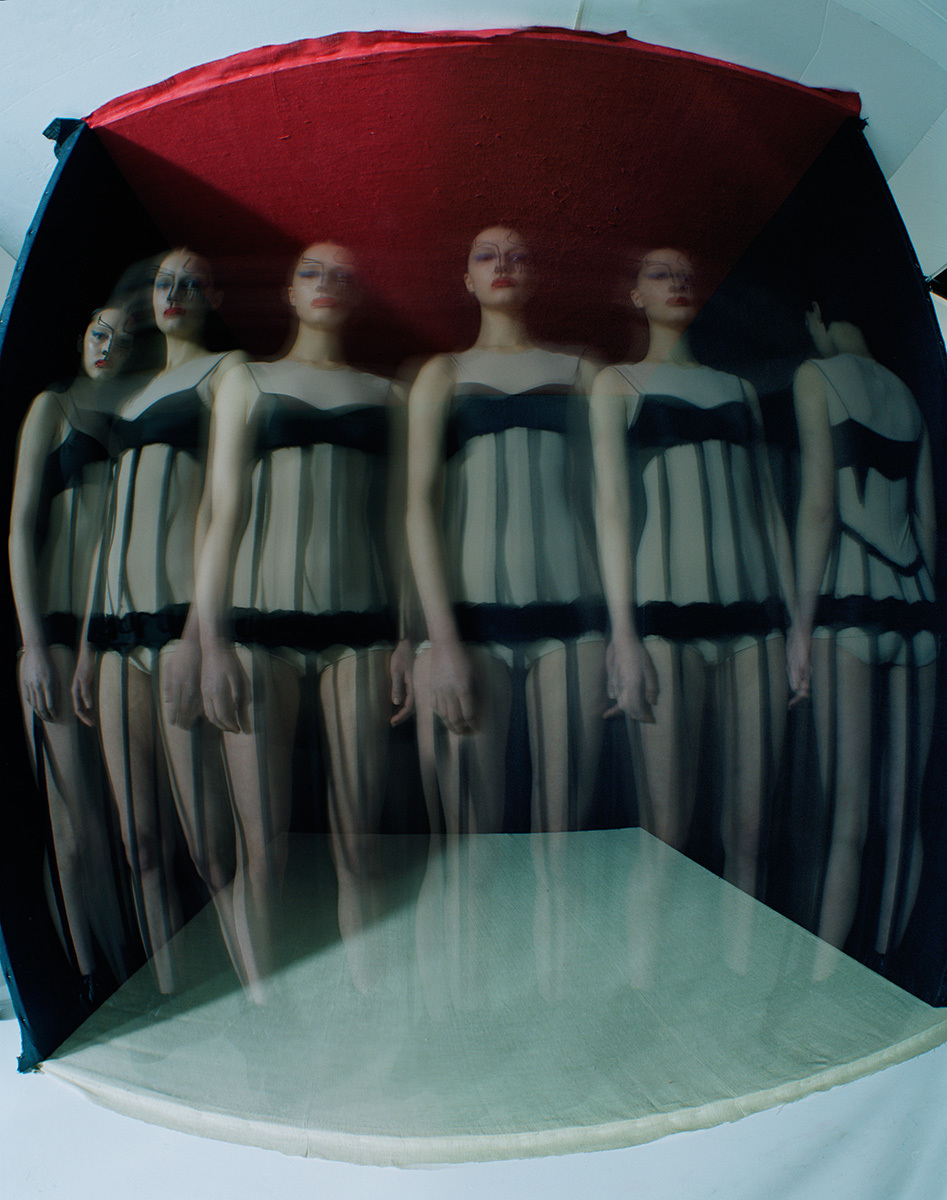
Which brings us back to Russo’s face illustrations. They have informed embroideries on transparent tulle; layered over the garments like a graphic Snapchat filter come to life. “Almost like a computer screen, the filters build up in an image. It’s how we’re all fragmenting into tribes, almost, aren’t we?” Galliano pauses. “The biologic, the ecologic, the macrobiotic — in search for some kind of truth today, I think.” He possesses the rare oxymoron of homespun splendor, in big knitted socks and no shoes, long shorts and an oversized chunky knit, and an artist’s headband that holds back his long, tied-up hair. But Galliano still looks like the fairy-tale admiral that took those regal bows during the first part of his career, his kind eyes sparkling with supernatural glint. Next to the gilded chair is a delicate tea set, an indication of his healthy lifestyle. Back on the topic of social media, he continues: “You know, all that stuff has now scientifically been proven to produce dopamine. No one’s talking about it. You’ve got no friends, you hook up to ten, you get ten replies and you’re like, ‘Great! He loves me!'” He’ll occasionally break out in exuberant exclamations like that, snapping you out of the spell his hypnotizing voice puts you under. “It’s happening. It’s a reality of today. You’ve got Kendall, who actually closed her account to detox,” he says, referring to Jenner, who temporarily shut down her Instagram last year citing digital dependency. “How genius was that, to have millions of followers and say that to young little girls?” He speaks like no one else, in a kind of ennobled South London accent, a grand and slightly grainy bass that curls around each word and makes it his own. In the privacy Maison Margiela has given him by proxy, Galliano has become a designers’ designer, much in the vein of what David Bowie, Prince, or Michael Jackson represented to the music industry. Like them, he’s a living substance of captivating star quality: that unicorn force, which is now marveling a new generation of young designers and fans, who connect with his legacy of grand and often emotional fashion gestures. They’re watching his old shows on YouTube, from his eponymous John Galliano collections (1989-2011) to his shows for Givenchy (1995-96) and his epic tenure at Christian Dior (1996-2011), enthralled with the opulent theatricality and storytelling he’s always executed with such precision.

Galliano is now fusing his prolific haute couture with the Belgian avant-garde codes of Maison Margiela, which Martin Margiela sold to the Only The Brave group in 2002 and eventually left in 2009. “A lot of it is rooted in reality: normcore shapes reconfigured,” he says of the Artisanal collection at hand, pretty much summing up the essence of the Maison. In recent years, no house has had as big an effect on emerging fashion as the ingenious codes of Margiela’s legacy. New generation Paris brands like Vetements and Off-White openly appropriate Martin Margiela’s deconstructivist and elevated normcore, while in London emerging designers like Charles Jeffrey and Matty Bovan identify with John Galliano’s historicist and eclectic grandeur. In a sweeping turn of magic, Maison Margiela now represents the synergy of what compels the broad young guard of designers most: the mystery of Martin Margiela and the myth of John Galliano. Jeffrey and Bovan got to meet him last year when Tim Walker invited them to style a shoot with the designer for Love. “It was in a context different to him having interns, I think,” Charles Jeffrey reflects when I ask him how it went. “It was more like, ‘we are two people, who are heavily inspired by you and your work and what you stand for.’ We were both looking really colorful — Matty is like a painting — and you could see John analyzing us,” he smiles.

Next to their work, the two young designers share Galliano’s affinity for expressing themselves through their personal looks. Unlike the dressed-down designers, who ruled the fashion scene for much of the 2010s, these emerging creatives represent a self-staging more in touch with what Galliano has often embodied. “Meeting John was an amazing moment,” Matty Bovan says. “From a young age he was a huge inspiration to me — the grand master of creativity. Just the pure vision in each collection and the way it’s presented, the sensitivity to detail and the spectacle done with such a hand,” he reflects. “The references always so fully researched and kind of mashed together in an amazingly instinctive, beautiful way.” If London’s young fashion industry loves Galliano, it’s reciprocated at Maison Margiela where you’ll hear a few London accents in the corridors. Back in the ateliers, Galliano’s assistant — clad in the lab coat everyone wears — brings out look 24 from the Artisanal collection.
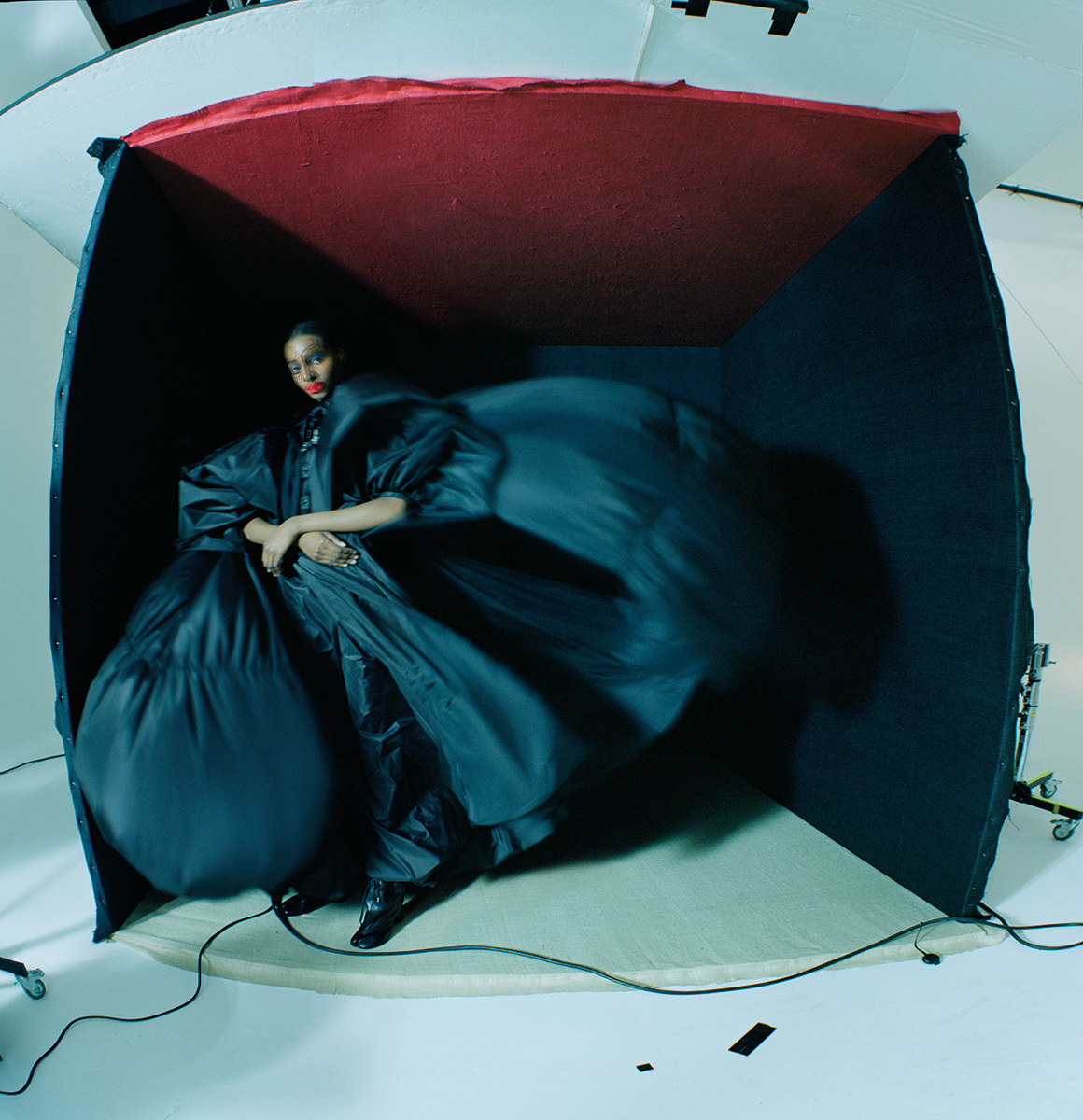
A collaboration with Benjamin Shine, a young artist Galliano has imported from London, it’s a white trench coat lined in black tulle pouring out from the inside and flowing around the coat to form a three-dimensional face made entirely in tulle, hand-crafted to the coat by Shine. A few weeks after the show, which gets rave reviews, the designer’s friend Grace Coddington styles the dress in a story shot by Tim Walker for these pages, which Galliano collaborates on. It’s the legendary stylist’s first editorial away from US Vogue since stepping down last year from the creative director position she held at the magazine for 30 years. And it’s all Galliano’s spring/summer 17 Artisanal collection for Maison Margiela, an indication of the emotional bonds tied to him and his work not only by a new guard of fans, but by every generation in this industry. In late March, while working on this feature, I receive a message from him: “I would like to add,” Galliano writes, “what an honor it was to work with Grace, Tim, and i-D.” His gesture makes me think of the statement put out by Maison Margiela in collective wording — true to house tradition — after the show in January: “This collection is about adding filters but as much about removing them,” the house wrote. “Sharing is about connecting with a community, becoming part of a union, and relating through mutual emotions rooted in memories.”
Credits
Photography Tim Walker
Styling Grace Coddington
Hair Eugene Souleiman
Makeup Pat McGrath
Hair concept and direction by Eugene Souleiman at Streeters for Wella professionals using Balmain hair extensions.
Makeup Pat McGrath at Streeters for Pat McGrath Lab.
Set design Shona Heath.
Photography assistance Sarah Lloyd, Tony Ivanov.
Styling assistance Yvonne Banningan.
Hair assistance Alfie Sacket, Jaimie Tanner, Magdalena Loza, Shuhei Nishimura.
Makeup assistance Jenny Kuchera, Milka Kempanien, Mona Leanna, Andrew Colvin, Fatimot Isadare.
Set builder Clément Ottenwaelter.
Set design assistance Jess Murphy.
Casting director Madeleine Østlie at AAMO Casting.
Models Tami Williams at Storm. Irina Liss at Select. Yoon Young Bae at Elite.
Special thanks to Michaël Lacomblez and Hugo Alglave at Louis2 Production.
Models wear all clothing Maison Margiela Artisanal Designed by John Galliano.
